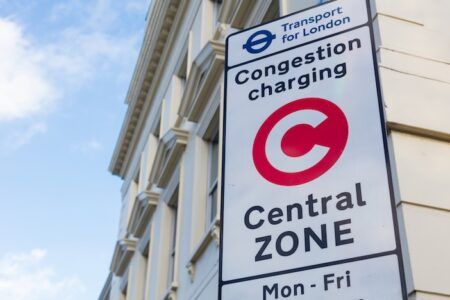UK Chancellor Rachel Reeves has confirmed a new mileage-based charge for electric vehicles that will come into effect in April 2028, marking the start of what could be a broader move to distance-based tolling – also known as road-user charging (RUC) – for all vehicles, as the UK Treasury seeks to offset declining fuel duty revenues.
The UK’s Office for Budget Responsibility has revealed that EV drivers will pay 3p per mile while plug-in hybrid owners will pay 1.5p per mile, with both rates increasing annually with inflation. The charge is expected to raise approximately £1.4 billion per year by 2029-30

For the average UK driver covering 8,500 miles annually, the new charge adds £255 to their road tax bill in 2028-29, on top of the existing £195 Vehicle Excise Duty. Speaking in Parliament, Reeves stated the measure aims to create “a fairer system for all drivers” as EV adoption accelerates.
“We strongly welcome today’s announcement by the Government setting out, for the first time in more than a decade, a shift to a distance-based national road pricing scheme,” says ITS UK’s chief executive Max Sugarman “The EV mileage charge is much needed in order to meet the emerging gap in tax revenue from falling fuel duty receipts, as our vehicle fleet electrifies, and means we can finally move to a fairer, more effective road tax system, that charges based on usage.”
However, the announcement is raising questions about implementation mechanisms as the government has said it is opting for a self-reporting system, rather than technology-based solutions proven effective in the United States.
It is reported that drivers will be asked to estimate their annual mileage at the start of the year and pay the charge upfront alongside VED. If they exceed their declared mileage, they would be required to top up the difference; if they drive fewer miles, the remainder could roll over to the following year.
The reliance on personal mileage predictions presents several implementation challenges for authorities. The self-reporting mechanism creates potential issues with accuracy, compliance and enforcement that technology-based alternatives have already addressed. Without electronic verification, the system depends on driver honesty and potentially cumbersome manual verification processes, likely through MOT testing or annual declarations, although a mechanism for verifying mileage has not been confirmed.

“The UK transport technology sector offers the proven capabilities and expertise to deliver this new road pricing scheme in a smarter, more effective way than a simple odometer reading,” says Sugarman. “The industry has the tools to introduce a road pricing system, utilising digital connectivity and roadside infrastructure, that can give policy-makers greater levers to manage their transport networks, and deliver a more effective system for the Treasury too, covering issues, for example, around foreign vehicles. We look forward to working with the Government, on behalf of the sector, as they consult on these proposals.”
Edmund King, AA president, acknowledged the complexity adding: “We will work with the government to ensure that whatever people drive, they will be treated fairly. We recognise that fuel-duty revenue is declining as drivers switch to electric vehicles. The AA is uniquely placed to assist Government in designing a fair and transparent system. The challenge is clear: it must be simple, trusted, and equitable for all road users.”

US technology-based road user charging
In contrast to the UK’s proposed self-reporting approach, several US states have successfully implemented road-user charging programmes using technology to accurately track mileage without relying on driver estimates.
Oregon launched the nation’s first operational road usage charge system, OReGO, in July 2015 after conducting pilot programmes in 2006-07 and 2012-13. The programme allows EV and high-efficiency vehicle owners to pay 2 cents per mile using various technology options including plug-in devices, built-in vehicle telematics, or manual odometer readings verified through a smartphone application. Participants receive fuel tax credits for combustion engines, and the system has operated continuously for nearly a decade.
Utah operates a similar voluntary programme for electric vehicles where drivers pay 1 cent per mile tracked through electronic devices, with the state promising participants “you’ll never pay more in the program, but you may pay less” than the alternative flat registration fee. Virginia’s Mileage Choice programme provides another operational model, allowing drivers to pay their Highway Use Fee per mile rather than as a lump sum.
These operational programmes demonstrate that technology-based distance charging is not merely theoretical but has proven feasible in practice. The systems offer multiple tracking options to address privacy concerns, from simple odometer readings to more sophisticated connected vehicle technologies, while maintaining accuracy and reducing opportunities for evasion.
Potential pathway to universal road pricing
While the UK charge initially targets only electric and plug-in hybrid vehicles, industry observers suggest this could represent the first step toward comprehensive distance-based road pricing for all vehicle types. Once the infrastructure and administrative systems are established for EV mileage charging, extending the scheme to petrol and diesel vehicles becomes a more straightforward proposition.
The Society of Motor Manufacturers and Traders expressed concerns about timing: “We recognise the need for a new approach to motoring taxes but at such a pivotal moment in the UK’s EV transition, this would be entirely the wrong measure at the wrong time.”
The 2028 implementation will follow a public consultation period launched after the Budget announcement, providing an opportunity for the government to consider more robust technological solutions and potentially draw lessons from international experience with road user charging systems.
As fuel duty revenues decline across developed nations – the UK currently collects over £25 billion annually from fuel duty – distance-based charging represents an increasingly common policy response. The critical question for UK traffic authorities is whether the self-reporting model will prove sufficient or whether technology-based alternatives will ultimately be necessary to ensure accuracy, fairness and compliance in a modernised road funding system.





